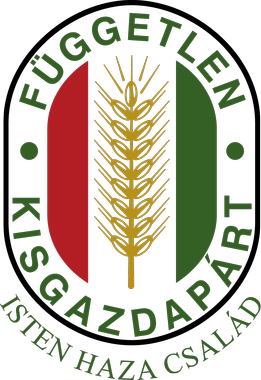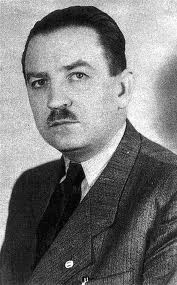
The Hungarian Democratic Forum was a centre-right political party in Hungary. It had a Hungarian nationalist, national-conservative, Christian-democratic ideology. The party was represented continuously in the National Assembly from the restoration of democracy in 1990 until 2010. It was dissolved on 8 April 2011.

Mátyás Rákosi was a Hungarian communist politician who was the de facto leader of Hungary from 1947 to 1956. He served first as General Secretary of the Hungarian Communist Party from 1945 to 1948 and then as General Secretary of the Hungarian Working People's Party from 1948 to 1956.

István Dobi was a Hungarian communist politician who was Prime Minister of Hungary from 1948 to 1952 and Chairman of the Presidential Council of the Hungarian People's Republic from 1952 to 1967.

Lajos Dinnyés was a Hungarian politician of the Smallholders Party who served as the first pro-communist Prime Minister of the Second Hungarian Republic from 1947 to 1948.

Ferenc Nagy was a Hungarian politician of the Smallholders Party who served as Prime Minister of Hungary from 1946 until his forced resignation in 1947. He was also a Speaker of the National Assembly of Hungary and a member of the High National Council from 1945 to 1946. Nagy was the second democratically elected prime minister of Hungary, and would be the last until 1990 not to be a Communist or fellow traveler. The subsequent Hungarian prime minister Imre Nagy was unrelated to him.

Béla Miklós de Dálnok, Vitéz of Dálnok was a Hungarian military officer and politician who served as acting Prime Minister of Hungary, at first in opposition, and then officially, from 1944 to 1945. He was the last Prime Minister of war-time Hungary.

The Christian Democratic People's Party is a right-wing Christian democratic political party in Hungary. It is officially a coalition partner of the ruling party, Fidesz, but is mostly considered a satellite party of Fidesz. The party has been unable to get into the Parliament on its own since the 1990s, as it was not able to pass the election threshold of 5% of the vote. Without Fidesz, its support is now low enough that it can no longer be measured, and even a leading Fidesz politician, János Lázár, stated that Fidesz does not consider the government to be a coalition government.

The Independent Smallholders, Agrarian Workers and Civic Party, known mostly by its acronym FKgP or its shortened form Independent Smallholders' Party, is a political party in Hungary. Since the 2002 parliamentary elections, the party has won no seats.

The Social Democratic Party of Hungary is a social democratic political party in Hungary. Historically, the party was dissolved during the occupation of Hungary by Nazi Germany (1944–1945) and the communist period of Hungary from 1948 to 1989, after being forced into a merger with the Communist Party. It worked legally for a short time during the Revolution of 1956.

The Hungarian People's Republic was a one-party socialist state from 20 August 1949 to 23 October 1989. It was governed by the Hungarian Socialist Workers' Party, which was under the influence of the Soviet Union. Pursuant to the 1944 Moscow Conference, Winston Churchill and Joseph Stalin had agreed that after the war Hungary was to be included in the Soviet sphere of influence. The HPR remained in existence until 1989, when opposition forces brought the end of communism in Hungary.
The Left Bloc was a political alliance in Hungary, functioning between 1946 and 1947. The Bloc included the Hungarian Communist Party (MKP), the Social Democratic Party (SZDP), the National Peasant Party (NPP) and the Trade Union Council (SZT).
Father István Balogh was a Hungarian Catholic priest and anti-communist politician who later tolerated the rule of the Hungarian Communist Party.
Parliamentary elections were held in Hungary on 4 November 1945. They came at a turbulent moment in the country's history: World War II had had a devastating impact; the Soviet Union was occupying it, with the Hungarian Communist Party growing in numbers; a land reform that March had radically altered the property structure; and inflation was rampant.
Parliamentary elections were held in Hungary on 15 May 1949. The Hungarian Independent People's Front, an umbrella group created that February to replace the National Independence Front and led by the Hungarian Working People's Party, but also including the remaining four non-communist parties, ran a single list of candidates espousing a common programme. With all organised opposition having been paralysed, the Front won 95.6% of the vote, presaging the result of elections through 1990. 71 (17.7%) elected deputies were female, up from 22 (5.4%) elected in 1947. Some 71% of those elected belonged to the Working People's Party, and a similar proportion were workers or peasants.

The Second Hungarian Republic was a parliamentary republic briefly established after the disestablishment of the Kingdom of Hungary on 1 February 1946 and was itself dissolved on 20 August 1949. It was succeeded by the Hungarian People's Republic.
In the May 1947 crises, also referred to as the exclusion crises, the Communists were excluded from government in Italy and France. The crises contributed to the start of the Cold War in Western Europe.

Béla Kovács was a Hungarian politician, who served as Minister of Agriculture from 1945 to 1946 and in the Hungarian Revolution of 1956.
Győző Drozdy was a Hungarian teacher, journalist, and politician.
The Hungarian Freedom Party, was a short-lived right-wing political party in Hungary between 1946 and 1947, it strongly opposed the Communist takeover. The party was revived for a short time during the Hungarian Revolution of 1956 and after the end of communism in 1989–90.















